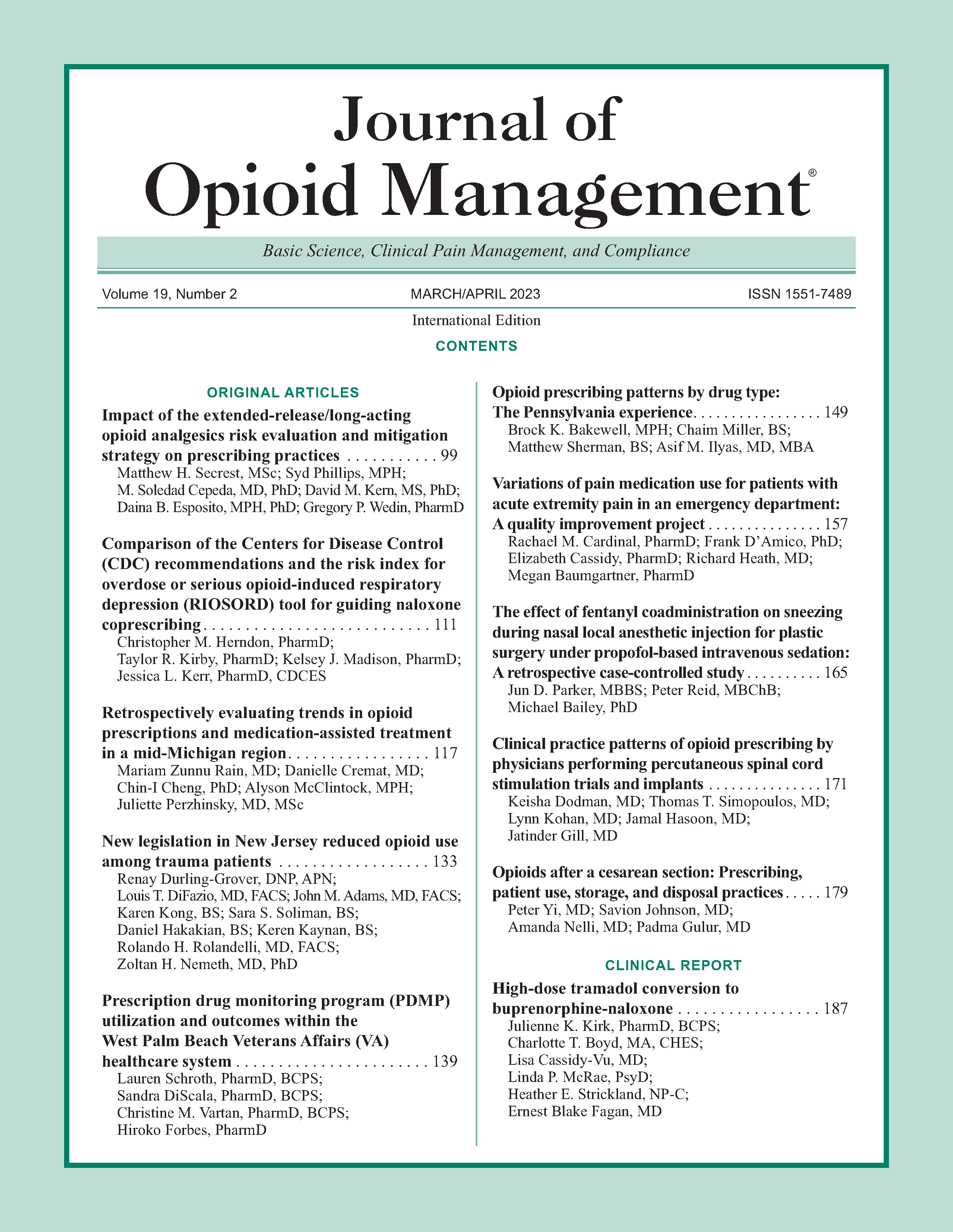The effect of fentanyl coadministration on sneezing during nasal local anesthetic injection for plastic surgery under propofol-based intravenous sedation: A retrospective case-controlled study
DOI:
https://doi.org/10.5055/jom.2023.0771Keywords:
sneeze, intravenous sedation, opioid, propofol, nasal injection, physiological reflexAbstract
Background: Injection of local anesthetic for surgical procedures on the skin of the nose under intravenous sedation can provoke sneezing, which can be hazardous to the patient, surgeon, and other staff. Yet, there is little information on factors that influence sneezing under these circumstances. The aim of our study was to investigate the influence of adding fentanyl to propofol-based sedation on the incidence of sneezing during local anesthetic injection on the nose for plastic surgery.
Methods: A retrospective chart review was conducted on 32 patients who had undergone plastic surgery procedures on the nose under local anesthetic with intravenous sedation.
Results: Twenty-two patients received fentanyl in addition to propofol. Of these, only two patients sneezed (9.1 percent). In contrast, nine out of the 10 patients who did not receive fentanyl sneezed (90 percent). This included two patients who had received midazolam and propofol.
Conclusions: These findings indicate that there was a high rate of sneezing during nasal local anesthetic injections performed under propofol-based intravenous sedation, unless the sedation was supplemented with fentanyl. We now recommend the coadministration of fentanyl during nasal local anesthetic injections under propofol-based sedation. Further studies are required to determine whether this observation is related to the depth of sedation alone, or whether the reduction in sneezing is related to the coadministration of an opioid. Further studies should also investigate potential side effects of coadministration of fentanyl or other opioids.
References
Levitzky BE, Lopez R, Dumot JA, et al.: Moderate sedation for elective upper endoscopy with balanced propofol versus fentanyl and midazolam alone: A randomized clinical trial. Endoscopy. 2012; 44(1): 13-20.
Poulos JE, Kalogerinis PT, Caudle JN: Propofol compared with combination propofol or midazolam/fentanyl for endoscopy in a community setting. AANA J. 2013; 81(1): 31-36.
VanNatta ME, Rex DK: Propofol alone titrated to deep sedation versus propofol in combination with opioids and/or benzodiazepines and titrated to moderate sedation for colonoscopy. Am J Gastroenterol. 2006; 101(10): 2209-2217.
Songu M, Cingi C: Sneeze reflex: Facts and fiction. Ther Adv Respir Dis. 2009; 3(3): 131-141.
Setzen S, Platt M: The dangers of sneezing: A review of injuries. Am J Rhinol Allergy. 2019; 33(3): 331-337.
Morley AM, Jazayeri F, Ali S, et al.: Factors prompting sneezing in intravenously sedated patients receiving local anesthetic injections to the eyelids. Ophthalmology. 2010; 117(5): 1032-1036.
Tao J, Nunery W, Kresovsky S, et al.: Efficacy of fentanyl or alfentanil in suppressing reflex sneezing after propofol sedation and periocular injection. Ophthalmic Plast Reconstr Surg. 2008; 24(6): 465-467.
Hakim KY, Alsaeid MA: Comparative study between the efficacy of fentanyl, antihistamines, and dexmedetomidine in suppressing photic sneeze reflex during peribulbar block. Anesth Essays Res. 2019; 13(1): 40-43.
Ahn ES, Mills DM, Meyer DR, et al.: Sneezing reflex associated with intravenous sedation and periocular anesthetic injection. Am J Ophthalmol. 2008; 146(1): 31-35.
National Health and Medical Research Council: National Statement on Ethical Conduct in Human Research. Canberra: NHMRC, 2007. Available at https://www.nhmrc.gov.au/aboutus/publications/national-statement-ethical-conduct-humanresearch-2007-updated-2018. Accessed October 5, 2019.
World Medical Association: World medical association declaration of Helsinki: Ethical principles for medical research involving human subjects. JAMA. 2013; 310(20): 2191-2194.
Gill M, Green SM, Krauss B: A study of the bispectral index monitor during procedural sedation and analgesia in the emergency department. Ann Emerg Med. 2003; 41(2): 234-241.
Australian and New Zealand College of Anaesthetics: Guidelines on sedation and/or analgesia for diagnostic and interventional medical, dental or surgical procedures. ANZCA Professional Document PS09. 2014. Available at http://www.anzca.edu.au/getattachment/resources/professionaldocuments/ps09-2014-guidelines-on-sedation-and-oranalgesia-for-diagnostic-and-interventional-medical-dentalor-surgical-procedures.pdf. Accessed January 10, 2018.
Sneyd JR: Excitatory events associated with propofol anaesthesia: A review. J R Soc Med. 1992; 85(5): 288-291.
Tawfik HA, Mostafa M: Sevoflurane versus propofol sedation during periocular anesthetic injections in oculoplastic procedures: An open-label randomized comparison. Saudi J Ophthalmol. 2015; 29(2): 126-129.
Bischoff WE, Swett K, Leng I, et al.: Exposure to influenza virus aerosols during routine patient care. J Infect Dis. 2013; 207(7): 1037-1046.
Jones RM, Brosseau LM: Aerosol transmission of infectious disease. J Occup Environ Med. 2015; 57(5): 501-508.
Xie X, Li Y, Chwang AT, et al.: How far droplets can move in indoor environments–revisiting the wells evaporation-falling curve. Indoor Air. 2007; 17(3): 211-225.
Amornyotin S: Sedation-related complications in gastrointestinal endoscopy. WJGE. 2013; 5(11): 527-533.
Published
How to Cite
Issue
Section
License
Copyright 2005-2025, Weston Medical Publishing, LLC and Journal of Opioid Management. All Rights Reserved.











